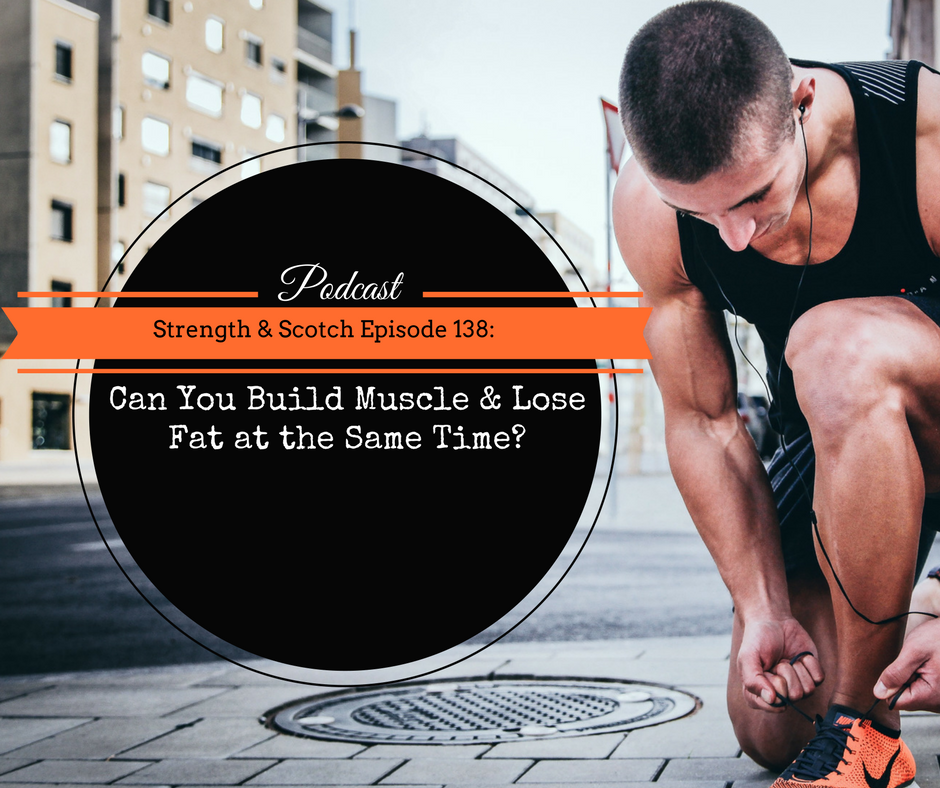SS 138 – Can You Build Muscle and Lose Fat at the Same Time?
Episode 138 Show Notes
Grant and Heavey tackle the concept of losing fat and gaining muscle simultaneously. Is this actually possible? Or does losing weight automatically mean you’re shedding off muscles too? Listen in and find out how resistance training, HIIT, and nutrition specifically play a part in this whole complicated process.
[01:15] Better Sleep, Better Sex
Grant read an article on Science Daily published by the North American Menopause Society where they reviewed close to 95,000 women. The study concluded that you need to get better sleep if you want more sex but if you want better sleep, you need to have more sex. The study found that being too tired is the number one reason people have lost desire for sex or ability to have sex. After orgasm, our bodies release oxytocin, a deep relaxation hormone. While it’s great to start your day with sex, it’s also good for a number of reasons. If you finish your day with sex, you’re more likely to have better sleep which can increase the amount of testosterone in men and women which then leads to an increase in sexual desire and reduced sexual dysfunction leading to more sex and better sleep. Interestingly, a meta-analysis that includes a study on men and women, women in their 50’s, and another study looking at college-aged students focusing on sleep and sex, suggesting that for those in a relationship, every hour they slept corresponded to higher desire, greater vaginal lubrication, and 14% increase in amount of sex the following day of the hour of sleep. The theories include feeling refreshed, relaxed, and energetic, along with improved hormone balance from the sleep.
[04:55] Prioritizing Sex for Health
Grant explains how society often frowns on discussing sex a lot but we need sex to be healthy. As athletes we worry about nutrition, our stress, and our exercise and we don’t prioritize sex, we’re really missing out on an important part of not just mental health, but actual physical health, hormone regulation, and sleep. Heavey adds many people think and talk about the evolutionary way of thinking and lifestyle as it relates to exercise, daily habits, and nutrition, but not as it pertains to sex. However, it’s something we’ve evolved to prioritize in life since we wouldn’t be here today if that wasn’t a priority for our species.
[06:40] Build Muscle and Lose Fat through Resistance Training
Moving on to our main topic today is this “holy grail” within fitness of whether you can lose fat and gain muscle at the same time. Heavey says the majority of studies that focus on weight loss show that about 20-30% of weight loss from the people that cut weight comes from lean mass. But that’s not a forgone conclusion. Digging into research on this topic, Heavey points out that one of the biggest pieces for people to maintain their muscle while they’re on a caloric deficit to try to lose weight or fat is resistance training. Lifting weights stimulates muscle protein synthesis which helps prevent or at least limit the amount of muscle loss while on a caloric deficit to cut weight.
[08:03] HIIT Training and Nutrition
Another training intervention that help prevents muscle loss is high intensity interval training (HIIT) which can stimulate muscle protein synthesis and help people at least maintain muscle mass. However, there is a ton of variability when it comes to studies supporting or negating the possibility of muscle gain during high intensity training. Grant adds that besides the exercise component, the nutrition component also plays a part where you have to eat less than what your body is burning to lose weight. When this happens, your body adapts and starts to burn less calories.
[09:03] It’s Not That Simple
Heavey says we try to simplify these things and make them fit into a box and that’s the research that gets presented to people through magazines, websites, and social media but nothing is very simple. He further explains that it’s so complex the way that the body responds to things. It’s not just, eat less calories than you’re consuming and all is good. There’s many layers to this.
[09:42] Muscle Needs Protein!
Grant and Heavey also center their discussion around protein which plays a big role in the nutritional element of maintaining muscle. Basically, muscle needs protein to survive and thrive. A couple of studies have shown that you need about 1.6 grams to 2 grams of protein per kilogram to reduce the loss of muscle mass while eating at a deficit to your caloric need. Grant actually sent Heavey an article showing a nine-month study where the participants lost three pound which they think is just crap. Meanwhile, Heavey found this four-week study wherein the researchers put on a weight loss clinic resulting to an average weight loss of 3.5 kilograms or over 17 pounds. Heavey stresses that a weight loss of seven pounds in a month is pretty aggressive.
[12:20] Dr. Oz and the Porn Analogy
Meanwhile, Grant and Heavey saw a magazine at the grocery store featuring Dr. Oz talking about his special diet where you could lose 20 pounds in like 20 days or whatever. But that’s not healthy or realistic. Heavey describes it as poisoning people’s minds. People have been conditioned to think that losing seven pounds in a month is not very much but Heavey actually says this is very aggressive. Grant gives this sensible analogy to porn where losing 20 pounds in 20 days is unrealistic and sets crazy expectations and this is similar to porn that shows unrealistic versions of sex that some people feel they need to live up to. It’s not realistic. It’s not healthy and it’s not possible. Sadly, Dr. Oz sensationalizes things in that same way.
[13:50] 40% Caloric Reduction
Back to the four-week study, these people were 40 overweight men with an average age of 23 years old and average body fat percentage at 24.2%. They are recreationally active which means they went out one to two days a week and did something like hiking or playing basketball. They were apparently former athletes but they let themselves go. So this group was put on a 40% caloric reduction as well as resistance or interval training six days a week. They were split into two groups. Group One was fed a protein diet and they were given all their meals for the entire four weeks. They got 1.2 grams per kilo of protein which is about 15% of the calories in their entire diet. Group Two got 2.4 grams per kilo of protein which made up about 35% of their goal intake. Their carbs were kept the same while their fats were altered to make up for the protein difference. The researchers kept the carbs the same because of the intensity of their training so they want to make sure there was no adverse effect from starving carbohydrates due to the high intensity training. Moreover, both groups drank whey protein immediately after the training session. The higher protein group had 49 grams of protein in their shake and the lower protein group had 15 grams of whey protein.
[16:38] Six Days a Week Training Program
The study training program was pretty aggressive at six days a week – two days a week of full body resistance training, two days a week of high intensity interval training, one day per week of cycling time trial, and one day a week of body weight plyometrics. The other piece given to them was a pedometer where they were instructed to hit 10,000 steps per day. So they had to make sure they were moving all day and that they’re eating at a pretty strong deficit.
[17:23] The Results – Who Lost More?
Both groups ended up losing the same amount of weight at 3.5 kilograms on average. Grant’s theory is that the protein group maintained more lean mass and lost fat. Heavey explains there are two protein groups. One group is eating 1.5 grams per kilo which is greater than the RDA. In fact, twice as much as the RDA (recommended daily allowance) and that still performs less than the one that’s 3x the RDA. When you account for the differences in lean mass, the higher protein group actually lost 4.7 kilos of fat mass while the lower protein group maintained their lean mass and ended up losing 3.5 grams of fat mass. This means that the higher protein group increased their muscle mass by 1.2 grams. This is incredible when you consider they’re eating at a 40% caloric deficit and those guys have to look shredded after that period.
[19:00] Simultaneous Fat Loss and Muscle Gain – It’s Possible!
The study also looked at other things such as hormone status, anaerobic and aerobic capacity, and strength markers across the group just to see any differences in performance and they all came about the same. The key thing measured here is the increase in muscle mass as compared to the lower protein group. Moreover, it’s not a small group since they studied 40 individuals. It shows you that it’s clearly possible to both lose fat and gain muscle simultaneously even over a shorter period of time. However, Heavey thinks the study is very aggressive and he personally wouldn’t recommend a protocol as aggressive as this for somebody.
The researchers actually made a note in the study citing that because of the extreme deficit they put the people on, they found that the participants by and large became obsessed with food after just one week of being on that deficit which sets the stage for an unhealthy relationship with food. They speculated that after the four-week period, they might actually have a hard time holding on to the changes because they might have the tendency to binge. Heavey says you can’t have an unhealthy relationship with food like this and introduce long term change that’s why being this aggressive is not healthy. Nevertheless, you can learn something from their protocol which is pretty solid. Heavey recommends reducing the caloric change since 40% is quite huge. In fact, he starts with 10% deficit with his clients. Ultimately, consuming 1 gram per protein is a solid approach whether you’re an athlete or somebody looking to gain muscle while losing fat.
Check out the gear page for everything Strength & Scotch! You’ll find a listing of all the supplements and other programs we’ve discussed on the show as well as our killer t-shirts!

